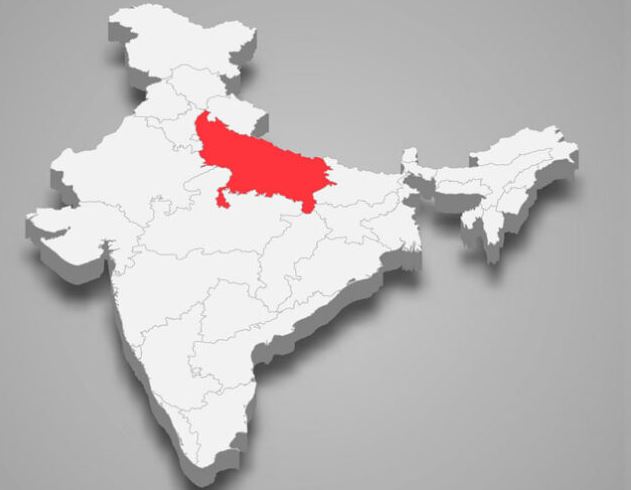The important points of Uttar Pradesh (UP) History during different rule, has been provided in this blog. These points are very useful for the students preparing for Uttar Pradesh Civil Services Exam – UPPSC PCS and UPSC IAS.
Uttar Pradesh history :
The Uttar Pradesh History is divided into following period :
- Prehistory and Mythology (up to c. 600 BCE)
- The Buddhist- Hindu Period (c. 600 BCE to c. 1200 CE)
- The Muslim Period (c. 1200 to c. 1775)
- The British Period (c. 1775 to 1947)
- The Post-Independence Period (1947 to the present)
Prehistory and Mythology (up to c. 600 BCE)
- Archaeological findings reveal insights in modern-day Uttar Pradesh, dating back to around 10,000 BCE.
- Vedic literature and ancient Indian epics like the Ramayana and Mahabharata are providing crucial knowledge about the region before the 7th century BCE.
- The Mahabharata is set around Hastinapur, whereas the Ramayana is centered on Ayodhya, the birthplace of Lord Rama.
- Mathura and Vrindavan are mythological sites associated with the birth of Krishna, another incarnation of Vishnu.
The Buddhist- Hindu Period (c. 600 BCE to c. 1200 CE)
- The history of India and Uttar Pradesh trace back to the end of the 7th century BCE, which is marked by the dominance of 16 great states in northern India, from which seven were falling within the boundaries of present-day Uttar Pradesh.
- From the 5th century BCE to the 6th century CE, the region was under the control of Magadha in Bihar and later Ujjain in Madhya Pradesh. Rulers included Chandragupta , Ashoka , Samudra Gupta, Chandra Gupta II , and Harsha.
- Harsha, a ruler who reigned from around 606 to 647 CE, controlled Uttar Pradesh from capital at Kanyakubja (modern Kannauj) and extending his rule over the parts of present-day Bihar, Madhya Pradesh, Punjab, and Rajasthan.
- The evolution of religion saw Brahmanism emerge from the ancient Vedic religion by the 6th century BCE, later it evolved into classical Hinduism by the 2nd century BCE. Buddhism, founded by Buddha, is spread across India, including Uttar Pradesh, with significant sites such as Sarnath and Kushinagara.
- In the beginning , Buddhism and Brahmanic or Hindu culture coexisted, the Buddhist art was flourishing under Ashoka’s reign and Hindu art reached its peak during the Gupta dynasty (4th to 6th century CE).
- After Harsha’s death, around 647 CE, there was a decline in Buddhism and a revival of Hinduism, which was led by philosopher Shankara, whom believed to have established the famous Badrinath temple in the Himalayas after visiting Varanasi and traveling through the plains of Uttar Pradesh.
The Muslim Period (c. 1200 to c. 1775)
- Muslim incursions began around 1000–30 CE, but Muslim rule over northern India, was established at late 12th century by Muʿizz al-Dīn Muḥammad ibn Sām (Muḥammad Ghūrī).
- For almost 600 years, Uttar Pradesh was ruled by various Muslim dynasties, which was centered in or near Delhi, starting with the Delhi Sultanate.
- In 1526, Bābur, a descendant of Genghis Khan and Timur, defeated Sultan Ibrāhīm Lodī and then founded the Mughal dynasty, which was dominated the subcontinent for over 200 years, centered in Uttar Pradesh.
- Under Akbar’s reign (1556–1605), the Mughal Empire promoted a new composite culture that blended elements of Hinduism and Islam. Akbar’s court was full of eminent figures in architecture, literature, painting, and music, regardless of caste or creed.
- The Mughal era saw the rise , such as Ramananda’s bhakti sect and Kabīr’s teachings marking the importance of the unity of religions.
- Decline of the Mughal Empire in the 18th century led to shift of cultural centers from Delhi to Lucknow, where under the nawab of Oudh, art, literature, music, and poetry flourished in an environment of communal harmony.
The British Period (c. 1775 to 1947)
- The East India Company acquired present-day Uttar Pradesh over 75 years, which is from the late 18th century to the mid-19th century, by taking territories from various powers including nawabs, the Sindhias of Gwalior, and the Gurkhas of Nepal.
- Uttar Pradesh then part of the Bengal Presidency, these territories were separated in 1833 to form North-Western Provinces (later the Agra Presidency), which included annexed kingdom of Oudh in 1856, forming United Provinces in 1877.
- The Indian Mutiny of 1857–58, which was in the United Provinces, it was a widespread revolt against the East India Company, leading to the transfer of administration from the Company to British crown in 1858.
- The United Provinces played a significant role in the rise of Indian nationalism, producing important leaders like Motilal Nehru, Pandit Madan Mohan Malaviya, Jawaharlal Nehru, and Purushottam Das Tandon.
- Mohandas (Mahatma) Gandhi’s noncooperation movement of 1920–22 had found strong support in the United Provinces but suspended after mob violence in Chauri Chaura.
- The United Provinces witnessed extensive development, including establishment of canals, railways, and modern education institutions.
Uttar Pradesh history : The Post-Independence Period (1947 to the present)

- In 1947, the United Provinces became part of independent India and was renamed Uttar Pradesh in 1950 under the new Indian constitution.
- Uttar Pradesh played a significant role in Indian politics, producing several prime ministers like Jawaharlal Nehru, Indira Gandhi, and Atal Bihari Vajpayee, along leaders of national opposition parties like Acharya Narendra Dev and Mulayam Singh Yadav.
- State-level politics in Uttar Pradesh characterized by frequent shifts in government control between parties like the BJP, SP, and BSP since the early 1990s.
- Instances of direct central government control occurred, notably in 1992–93 following rioting after the destruction of Babri Masjid in Ayodhya.
- Unrest in Himalayan regions of Uttar Pradesh led to demands for a separate state. This culminated in the formation of Uttaranchal (now Uttarakhand) in November 2000, carving the northwestern part of Uttar Pradesh.